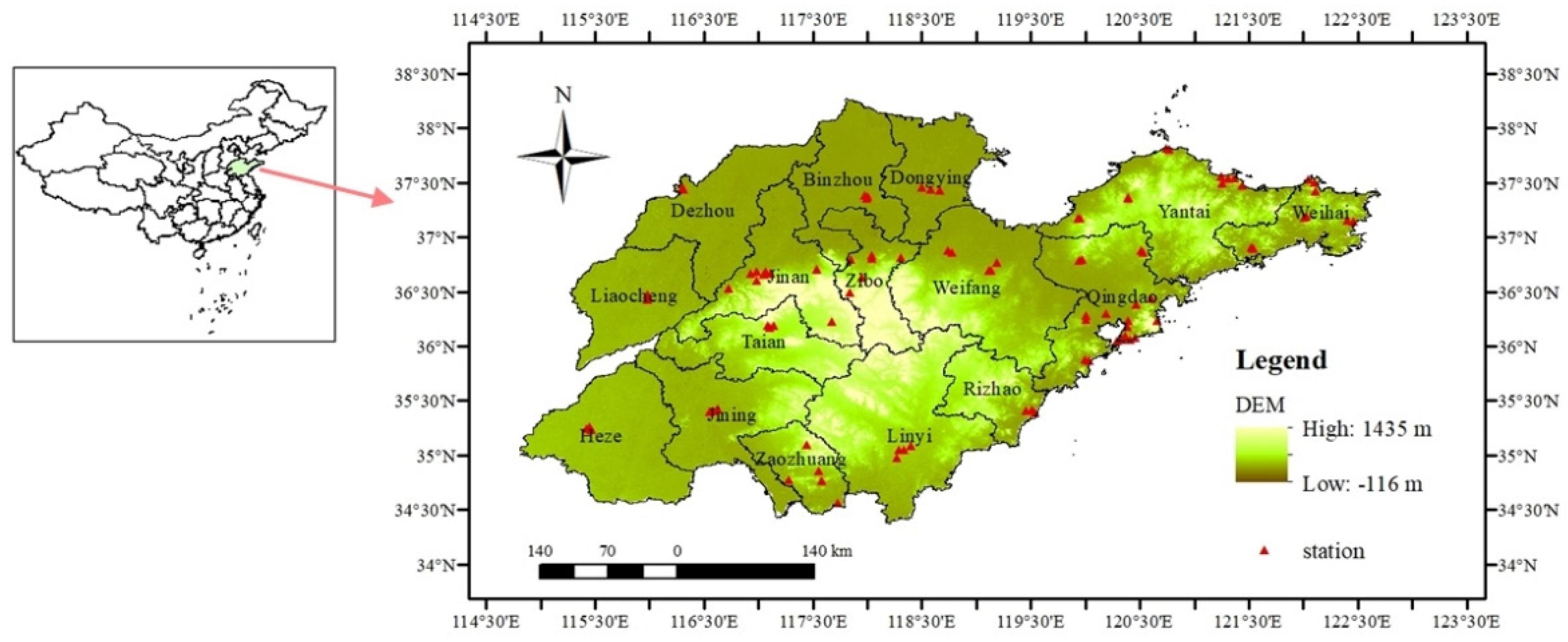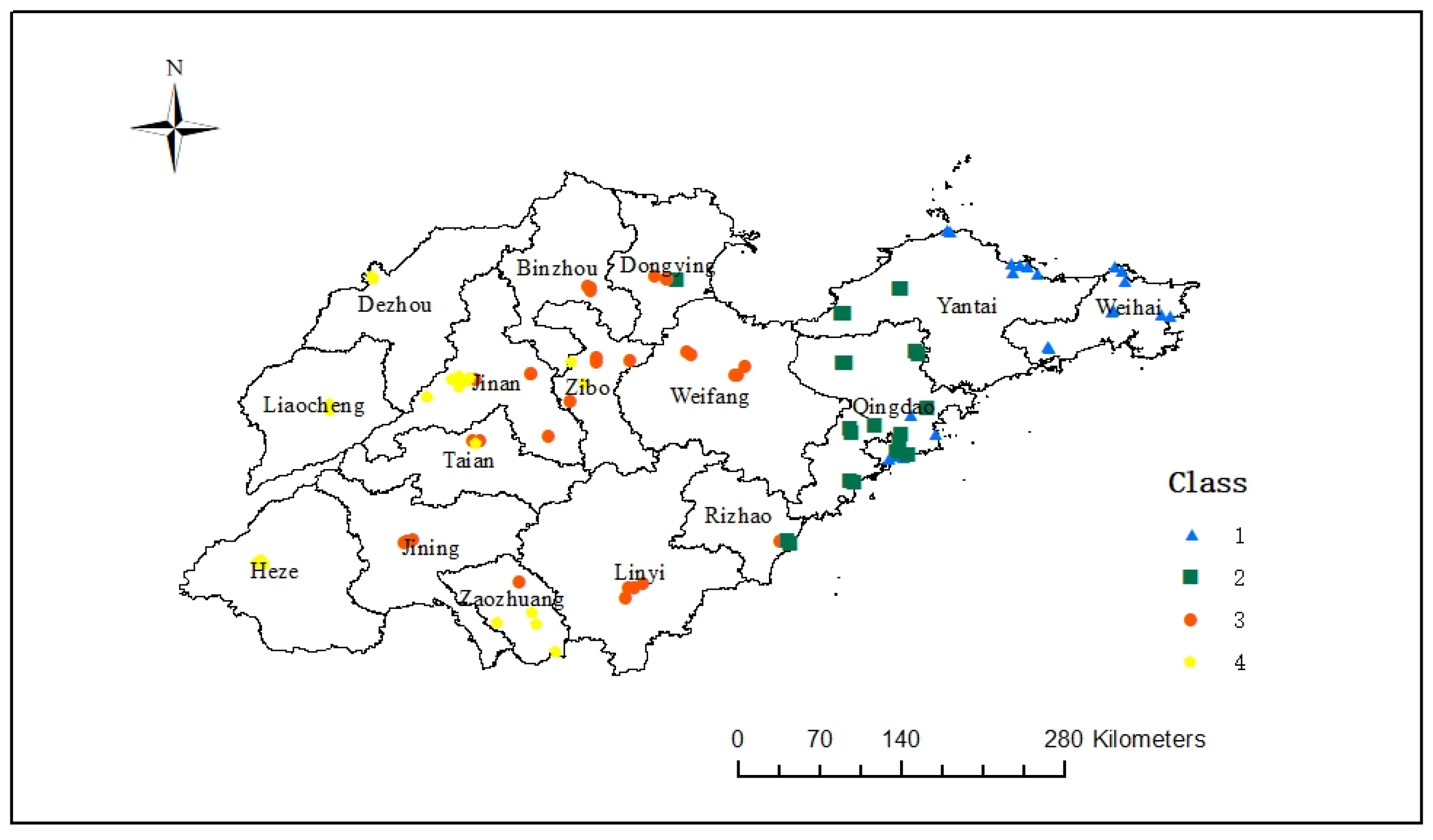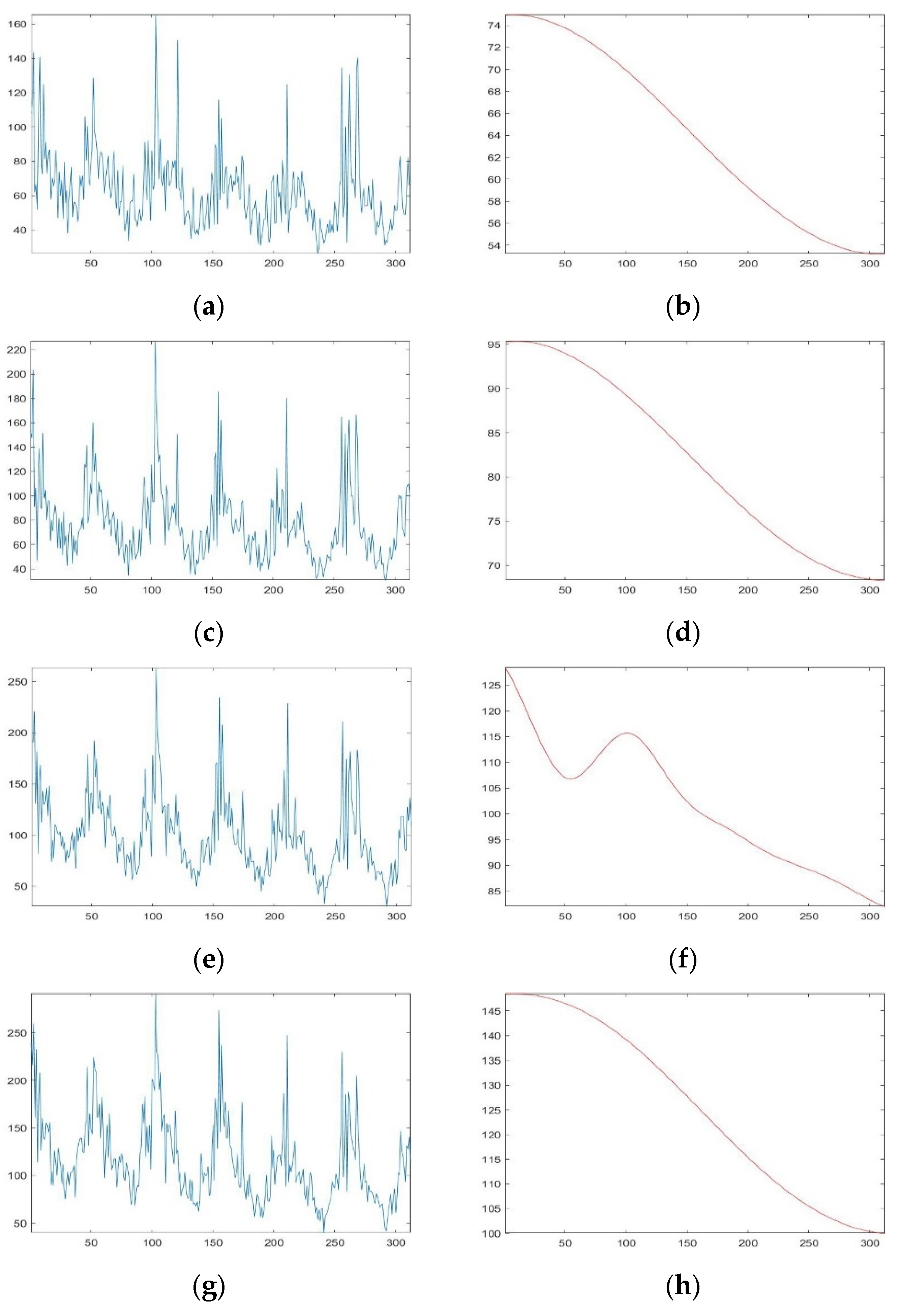An Empirical Mode Decomposition for Establishing Spatiotemporal Air Quality Trends in Shandong Province, China
Abstract
:1. Introduction
2. Methods
2.1. Data Source
2.2. Temporal Period and Trend Decomposition
3. Results
3.1. Overview of the Data Set
3.2. Spatial Distribution of Station Clustering
3.3. Temporal Trend of the AQI
3.4. Spatial Pattern of the Temporal Trend of Mass Concentration at Stations
4. Discussion
5. Conclusions
Supplementary Materials
Author Contributions
Funding
Institutional Review Board Statement
Informed Consent Statement
Data Availability Statement
Conflicts of Interest
References
- Lelieveld, J.; Evans, J.S.; Fnais, M.; Giannadaki, D.; Pozzer, A. The contribution of outdoor air pollution sources to premature mortality on a global scale. Nature 2015, 525, 367–371. [Google Scholar] [CrossRef] [PubMed]
- Wu, S.; Deng, F.; Huang, J.; Wang, H.; Shima, M.; Wang, X.; Qin, Y.; Zheng, C.; Wei, H.; Hao, Y. Blood Pressure Changes and Chemical Constituents of Particulate Air Pollution: Results from the Healthy Volunteer Natural Relocation (HVNR) Study. Environ. Health Perspect. 2013, 121, 66–72. [Google Scholar] [CrossRef] [PubMed]
- Qiu, H.; Yu, T.S.; Tian, L.; Wang, X.; Tse, L.A.; Wong, T. Effects of Coarse Participate Matter on Emergency Hospital Admissions for Respiratory Diseases: A Time-Series Analysis in Hong Kong. Environ. Health Perspect. 2012, 120, 572–576. [Google Scholar] [CrossRef] [PubMed] [Green Version]
- Brook, R.D.; Rajagopalan, S.; Pope, C.A.; Brook, J.R.; Kaufman, J.D. Particulate matter air pollution and cardiovascular disease: An update to the scientific statement from the American Heart Association. Circulation 2010, 121, 2331–2378. [Google Scholar] [CrossRef] [PubMed] [Green Version]
- Hu, M.; Jia, L.; Wang, J.; Pan, Y. Spatial and temporal characteristics of particulate matter in Beijing, China using the Empirical Mode Decomposition method. Sci. Total Environ. 2013, 458–460, 70–80. [Google Scholar] [CrossRef] [PubMed]
- Chen, Z.; Chen, D.; Wen, W.; Zhuang, Y.; Kwan, M.P.; Chen, B.; Zhao, B.; Yang, L.; Gao, B.; Li, R. Evaluating the “2+26” regional strategy for air quality improvement during two air pollution alerts in Beijing: Variations in PM2.5 concentrations, source apportionment, and the relative contribution of local emission and regional transport. Atmos. Chem. Phys. 2019, 19, 6879–6891. [Google Scholar] [CrossRef] [Green Version]
- Song, C.; Wu, L.; Xie, Y.; He, J.; Chen, X.; Wang, T.; Lin, Y.; Jin, T.; Wang, A.; Liu, Y. Air pollution in China: Status and spatiotemporal variations. Environ. Pollut. 2017, 227, 334–347. [Google Scholar] [CrossRef] [PubMed]
- Zhang, Q.; Zheng, Y.; Tong, D.; Shao, M.; Hao, J. Drivers of improved PM 2.5 air quality in China from 2013 to 2017. Proc. Natl. Acad. Sci. USA 2019, 116, 201907956. [Google Scholar] [CrossRef] [PubMed] [Green Version]
- Liu, Q.; Wang, S.; Zhang, W.; Jiaming, L.; Dong, G. The effect of natural and anthropogenic factors on PM2.5: Empirical evidence from Chinese cities with different income levels. Sci. Total Environ. 2019, 653, 157–167. [Google Scholar] [CrossRef] [PubMed]
- Wolf, T.; Pettersson, L.H.; Esau, I. A very high-resolution assessment and modelling of urban air quality. Atmos. Chem. Phys. 2020, 20, 625–647. [Google Scholar] [CrossRef] [Green Version]
- Thunis, P.; Clappier, A.; Pisoni, E.; Degraeuwe, B. Quantification of non-linearities as a function of time averaging in regional air quality modeling applications. Atmos. Environ. 2015, 103, 263–275. [Google Scholar] [CrossRef]
- China, M. Ambient Air Quality Standards (GB 3095-2012); China Environmental Science Press: Beijing, China, 2012. Available online: http://english.mee.gov.cn/Resources/standards/Air_Environment/quality_standard1/201605/t20160511_337502.shtml (accessed on 10 April 2020).
- Jain, A.K. Data clustering: 50 years beyond K-means. Pattern Recogn. Lett. 2010, 31, 651–666. [Google Scholar] [CrossRef]
- Joshi, K.D.; Nalwade, P.S. Modified K-Means for Better Initial Cluster Centres. Int. J. Comput. Sci. Mob. Comput. 2013, 2, 219–223. [Google Scholar]
- R Core Team. R: A Language and Environment for Statistical Computing; R Foundation for Statistical Computing: Vienna, Austria, 2012; Available online: https://www.r-project.org/ (accessed on 5 March 2020).
- Karatzoglou, A.; Smola, A.; Hornik, K.; Zeileis, A. Kernlab—An S4 Package for Kernel Methods in R. J. Stat. Softw. 2004, 11, 1–20. [Google Scholar] [CrossRef] [Green Version]
- Huang, N.; Wu, M.; Long, S.R.; Shen, S.; Qu, W.; Gloersen, P.; Fan, K.L. A confidence limit for the empirical mode decomposition and Hilbert spectral analysis. Proc. R. Soc. Lond. A 2003, 459, 2317–2345. [Google Scholar] [CrossRef]
- Huang, N.; Shen, Z.; Long, S.R.; Wu, M.C.; Shih, H.H.; Zheng, Q.; Yen, N.C.; Tung, C.C.; Liu, H.H. The empirical mode decomposition and the Hilbert spectrum for nonlinear and non-stationary time series analysis. Proc. R. Soc. Lond. A 1998, 454, 903–995. [Google Scholar] [CrossRef]
- Cheng, J.; Yu, D.; Yu, Y. Research on the intrinsic mode function (IMF) criterion in EMD method. Mech. Syst. Signal Process 2006, 20, 817–824. [Google Scholar]
- Rilling, G.; Flandrin, P.; Goncalves, P. On empirical mode decomposition and its algorithms. In Proceedings of the IEEE-EURASIP Workshop on Nonlinear Signal and Image Processing, Grado, Italy, 8–11 June 2003; Available online: https://hal.inria.fr/inria-00570628/en/ (accessed on 25 May 2020).
- He, J. Analysis on the Temporal and Spatial Distribution, Meteorological Impact and Health Risk of Air Pollutants in Shandong Province. Master’s Thesis, Nanjing University of Information Science and Technology, Nanjing, China, 2018. [Google Scholar]
- Luo, H.; Astitha, M.; Hogrefe, C.; Mathur, R.; Rao, S.T. Evaluating trends and seasonality in modeled PM2.5 concentrations using empirical mode decomposition. Atmos. Chem. Phys. 2020, 20, 13801–13815. [Google Scholar] [CrossRef]
- Fu, M.; Le, C.; Fan, T.; Prakapovich, R.; Manko, D.; Dmytrenko, O.; Lande, D.; Shahid, S.; Yaseen, Z.M. Integration of complete ensemble empirical mode decomposition with deep long short-term memory model for particulate matter concentration prediction. Environ. Sci. Pollut. Res. 2021. [Google Scholar] [CrossRef]
- Jiao, L. Environmentally Air Quality of Shandong Province Improving Year-on-Year in 2014. Available online: http://www.iqilu.com/html/zdys/news/2015/0518/2408238.shtml2015 (accessed on 25 October 2021).




Publisher’s Note: MDPI stays neutral with regard to jurisdictional claims in published maps and institutional affiliations. |
© 2021 by the authors. Licensee MDPI, Basel, Switzerland. This article is an open access article distributed under the terms and conditions of the Creative Commons Attribution (CC BY) license (https://creativecommons.org/licenses/by/4.0/).
Share and Cite
Wu, H.; Hu, M.; Zhang, Y.; Han, Y. An Empirical Mode Decomposition for Establishing Spatiotemporal Air Quality Trends in Shandong Province, China. Sustainability 2021, 13, 12901. https://doi.org/10.3390/su132212901
Wu H, Hu M, Zhang Y, Han Y. An Empirical Mode Decomposition for Establishing Spatiotemporal Air Quality Trends in Shandong Province, China. Sustainability. 2021; 13(22):12901. https://doi.org/10.3390/su132212901
Chicago/Turabian StyleWu, Huisheng, Maogui Hu, Yaping Zhang, and Yuan Han. 2021. "An Empirical Mode Decomposition for Establishing Spatiotemporal Air Quality Trends in Shandong Province, China" Sustainability 13, no. 22: 12901. https://doi.org/10.3390/su132212901
APA StyleWu, H., Hu, M., Zhang, Y., & Han, Y. (2021). An Empirical Mode Decomposition for Establishing Spatiotemporal Air Quality Trends in Shandong Province, China. Sustainability, 13(22), 12901. https://doi.org/10.3390/su132212901





